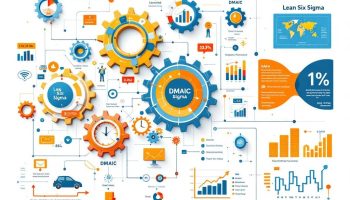
Understanding Quality Assurance Techniques in Construction
Quality assurance techniques in construction include nine critical methods that ensure projects meet specified standards throughout their lifecycle. These techniques create a comprehensive framework for delivering top-quality construction outcomes while reducing defects and rework. From pre-construction planning and material testing to technology integration and independent audits, these approaches help maintain construction excellence.
Business Impact of Quality Assurance in Construction
Quality assurance techniques in construction directly impact your company’s financial performance by preventing costly errors, cutting liability risks, and boosting your market reputation. Effective implementation minimizes expensive corrections and schedule delays while optimizing resource use and improving client satisfaction. For construction businesses, strong quality assurance processes provide a competitive edge, showing your dedication to excellence that attracts high-value clients and supports better profit margins. These techniques also help you stay compliant with regulations, reducing legal risks that could result in financial penalties or lawsuits.
Quality Assurance Techniques in Construction: Discover 9 Essential Strategies for Success
Ensuring quality in construction is paramount for project success, and implementing effective quality assurance techniques is the key to achieving this goal. In this section, we present nine essential strategies that can transform the quality management process in your construction projects. From pre-construction planning to advanced technology integration, each technique focuses on maintaining high standards throughout the project lifecycle. By understanding and applying these methods, you can reduce rework, enhance efficiency, and boost stakeholder confidence. Whether you are a project manager, contractor, or quality assurance professional, these insights will provide practical guidance for fostering a culture of quality within your team. Let’s explore these strategies that can help elevate your construction projects to new heights.
1. Pre-Construction Quality Planning
Implementing effective quality assurance techniques in construction begins well before breaking ground. Pre-construction quality planning establishes the foundation for excellence throughout your project lifecycle. This critical first phase involves developing project-specific quality standards that align with both industry regulations and client expectations.
Your team should identify critical inspection points where quality checks must occur to prevent costly rework later. These inspection points serve as gatekeepers in your quality assurance process, ensuring no defects progress to subsequent construction phases.
Creating comprehensive quality control checklists provides your field teams with clear verification steps for each construction element. These checklists should incorporate:
- Material specification requirements
- Installation tolerance limits
- Testing frequency requirements
- Documentation needs
- Acceptance criteria
Integrating your quality planning with the project timeline and milestones ensures quality activities are scheduled appropriately. This strategic planning approach prevents quality checks from becoming bottlenecks while maintaining construction momentum. When quality assurance techniques in construction are established early, your project benefits from reduced rework, improved efficiency, and enhanced stakeholder confidence.
2. Material Testing and Verification
Implementing effective quality assurance techniques in construction requires rigorous material testing protocols. You need to establish comprehensive testing procedures that verify all materials meet project specifications before installation. This process begins with thorough documentation of material requirements, including strength, durability, and performance characteristics.
Sample collection represents a critical component of your quality assurance program. Materials should undergo systematic testing by certified laboratories to confirm compliance with both industry standards and project-specific requirements. Consider implementing these key verification methods:
- Pre-installation testing of concrete mixtures for slump, air content, and compressive strength
- Structural steel verification through ultrasonic and magnetic particle testing
- Soil compaction testing at specified intervals during site preparation
- Asphalt mixture analysis for proper aggregate gradation and bitumen content
Digital tracking systems enhance your project assurance efforts by creating verifiable records of all test results and material certifications. These systems allow immediate access to quality documentation during inspections and provide traceability throughout the construction lifecycle. When implementing material verification programs, prioritize testing at critical structural points where failure would pose significant safety or financial risks.
Expert Insight: To ensure quality in construction, implement rigorous material testing protocols. Focus on pre-installation testing and utilize certified labs to verify compliance with standards. Integrating digital tracking systems enhances traceability, providing immediate access to documentation and prioritizing testing at critical structural points to mitigate risks.
3. Regular Site Inspections
Regular site inspections are a cornerstone of quality assurance techniques in construction projects. You need to implement daily walkthrough protocols that systematically cover all active work areas to identify potential issues before they escalate. Quality assurance techniques in construction require thorough digital documentation, which can be streamlined using specialized mobile apps that allow inspectors to record findings in real-time while on site.
Photo documentation serves as visual evidence of compliance with project specifications. Establish clear requirements for what must be photographed, including:
- All structural connections before covering
- Installed MEP systems prior to closing walls
- Concrete formwork before pouring
- Completed work areas showing compliance with specifications
Real-time reporting systems enable immediate notification of quality issues to relevant stakeholders, facilitating collaborative problem-solving and quick resolution. These systems should integrate with your project management platform, creating an auditable trail of inspections and responses. By conducting consistent inspections, you can identify patterns of quality issues and address root causes before they impact the project schedule or budget. The data collected during regular inspections also provides valuable metrics for continuous improvement in your construction quality processes.
Expert Insight: Conducting regular site inspections is essential for quality assurance in construction. Utilize mobile apps for real-time documentation and photo evidence to identify issues early. Integrate reporting systems with project management tools to promote collaboration and enable continuous improvement in construction processes.
“`html
4. Advanced Construction Technology for Quality Assurance
Implementing technology solutions represents a transformative approach to quality assurance techniques in construction projects. Building Information Modeling (BIM) integration allows your team to identify clashes and quality issues before they manifest on-site, significantly reducing rework costs. Quality assurance techniques in construction have evolved dramatically with these digital tools, enabling more precise verification and documentation.
Drone surveys provide comprehensive aerial documentation of construction progress, helping you monitor quality from perspectives previously unavailable. These unmanned aircraft capture high-resolution images that can be used to verify project assurance requirements and identify potential issues before they escalate.
3D scanning technology measures as-built conditions with millimeter accuracy, allowing for:
- Immediate comparison against design specifications
- Early detection of dimensional irregularities
- Documentation of hidden elements before enclosure
- Verification of complex geometric structures
Digital twin development creates virtual replicas of physical assets, enabling you to compare actual construction against intended designs. This technology facilitates collaborative problem-solving across project teams and supports effective project integration management by connecting various quality control systems into a cohesive framework.
“`
Expert Insight: Leverage advanced construction technologies like BIM, drone surveys, and 3D scanning to enhance quality assurance. These tools enable early detection of issues, precise documentation, and effective collaboration across teams, ultimately reducing rework costs and improving project outcomes through a cohesive integration of quality control systems.
5. Quality Control Documentation System
Implementing an effective quality control documentation system is vital for maintaining quality assurance techniques in construction projects. A comprehensive digital document management platform allows you to track and verify all quality-related activities throughout the construction lifecycle. This centralized approach ensures that quality standards are consistently applied and verified.
Standardized forms and templates create uniformity in how quality assurance techniques in construction are documented and reviewed. You can develop custom templates for inspections, material testing, and non-conformance reports that align with project specifications. These templates streamline the documentation process and reduce the likelihood of oversight.
Cloud-based storage solutions provide several advantages for construction quality management:
- Secure and centralized access to all quality documents
- Version control to prevent outdated information use
- Disaster recovery capabilities to protect critical data
- Mobile accessibility for on-site quality verification
Real-time collaboration tools enhance team collaboration on projects by allowing immediate sharing of quality findings. When inspectors identify issues, they can instantly notify relevant stakeholders and initiate corrective actions. This significantly reduces response time and prevents quality issues from impacting downstream construction activities.
Expert Insight: To ensure quality control in construction, establish a comprehensive digital documentation system using standardized templates for inspections and reports. Embrace cloud-based storage for secure, centralized access and real-time collaboration tools that enable swift communication and corrective action, minimizing response times and enhancing overall project quality.
6. Workforce Training and Quality Certification Programs
Implementing effective quality assurance techniques in construction requires a well-trained workforce. Your team’s knowledge and skills directly impact construction quality outcomes. Regular workforce skill assessments help identify knowledge gaps where quality issues might emerge, allowing you to address them proactively through targeted training.
Ongoing technical training sessions focused on quality assurance techniques in construction should be scheduled quarterly to keep your team updated on industry best practices. These sessions might include:
- Material handling and inspection procedures
- Documentation requirements and protocols
- Equipment calibration and maintenance
- Code compliance verification techniques
A robust certification tracking system ensures all personnel maintain current qualifications relevant to quality assurance. This system should track professional development goals and certification expiration dates, generating automatic alerts when renewals are due.
Performance evaluation metrics tied to quality outcomes encourage accountability among team members. Consider implementing a scoring system that tracks:
- Error rates on inspections
- Documentation accuracy
- Response time to quality issues
- Adherence to quality protocols
By investing in training and certification, you create a quality-focused culture where every team member understands their role in maintaining construction standards. This proactive approach significantly reduces rework and quality-related delays.
7. Non-Conformance Management in Quality Assurance Techniques in Construction
Effective non-conformance management is a cornerstone of quality assurance techniques in construction projects. When construction elements fail to meet specified requirements, you need systematic approaches to address these issues promptly. Quality assurance techniques in construction include developing clear issue identification protocols that enable field teams to flag problems using standardized documentation methods.
Root cause analysis procedures form another critical component of non-conformance management. These analytical methods help you identify whether issues stem from design flaws, material defects, workmanship errors, or procedural gaps. Implementing thorough root cause analysis prevents recurring quality problems by addressing underlying factors rather than just symptoms.
Your corrective action tracking system should include:
- Assignment of responsibility for remediation
- Documentation of approved solutions
- Implementation timelines and milestones
- Verification processes for completed corrections
Prevention strategy development completes the non-conformance management cycle by transforming lessons learned into preventive measures. These strategies might include updated work procedures, enhanced training programs, or revised quality control checkpoints. Effective project issue management requires documenting these preventive actions to demonstrate continuous improvement in your quality assurance system.

8. Third-Party Quality Audits for Construction Quality Assurance
Implementing effective quality assurance techniques in construction requires independent verification to maintain objectivity and compliance. Third-party quality audits serve as critical checkpoints throughout your construction project, providing unbiased assessments of quality management systems and actual work output. These audits help identify gaps in your quality assurance techniques in construction that might otherwise be overlooked by internal teams.
Scheduling regular compliance checks throughout the project lifecycle ensures continuous adherence to industry standards and specifications. A well-structured post-implementation audit schedule might include monthly inspections during critical phases and quarterly comprehensive reviews. This approach prevents quality issues from compounding over time.
Engaging external quality experts brings specialized knowledge and fresh perspectives to your construction quality program. These professionals typically carry certifications in construction quality management and bring cross-industry experience that internal teams may lack. Their involvement helps validate that your quality assurance techniques meet or exceed industry benchmarks.
The implementation of audit findings represents the most crucial phase of the audit process. Each recommendation should be:
- Prioritized based on risk and impact
- Assigned clear ownership and deadlines
- Tracked through completion
- Verified through follow-up assessments
9. Construction Quality Analytics and Performance Metrics
Implementing effective quality assurance techniques in construction requires robust measurement systems. Quality metrics provide the backbone for continuous improvement in construction projects by quantifying performance and identifying areas needing attention. Your quality assurance program should include clearly defined Key Performance Indicators (KPIs) that measure defect rates, safety compliance, and material conformance across all project phases.
Successful data collection methodologies involve both automated systems and manual inspections to ensure comprehensive quality monitoring. Many construction firms implement database analytics tools to centralize quality data from multiple sources, making trend identification more efficient. This approach helps you detect patterns in construction quality issues before they become widespread problems.
Trend analysis procedures should examine quality metrics over time, identifying seasonal variations, contractor performance differences, and material-related challenges. Construction quality assurance techniques benefit from comparative analysis across similar projects to establish realistic benchmarks.
Performance improvement tracking closes the quality management loop by documenting remedial actions and measuring their effectiveness. Establish a system for defining project success criteria that includes quality targets alongside traditional schedule and budget metrics.
Quality assurance techniques in construction encompass nine essential methodologies that systematically prevent defects and ensure project excellence throughout the building lifecycle. From pre-construction planning and material testing to advanced technologies like BIM and 3D scanning, these techniques create a comprehensive framework for delivering structures that meet regulatory requirements and client expectations.
Quality assurance techniques in construction are indispensable for enterprise users seeking to minimize costly rework, reduce liability exposure, and maintain project timelines and budgets. By implementing systematic approaches like third-party audits, robust documentation systems, and performance metrics, construction companies can demonstrate regulatory compliance, enhance stakeholder confidence, and create measurable competitive advantages through superior quality outcomes.
Conclusion
Quality assurance techniques in construction provide a systematic framework for ensuring project excellence through nine essential methods that span from pre-construction planning to performance analytics. These techniques create a comprehensive approach that includes material testing, regular inspections, advanced technologies, robust documentation, workforce training, non-conformance management, and third-party audits—all working together to deliver structures that meet rigorous standards while minimizing costly rework and enhancing stakeholder confidence.
Actionable Steps
- Implement pre-construction quality planning with detailed checklists and critical inspection points to establish quality standards before breaking ground.
- Develop comprehensive material testing protocols with certified laboratory verification to ensure all materials meet specifications.
- Conduct systematic site inspections with real-time digital documentation to identify and address issues promptly.
- Integrate advanced technologies like BIM, drone surveys, and 3D scanning to enhance quality verification precision.
- Establish a digital quality control documentation system with standardized templates and cloud-based storage for transparent tracking throughout the project lifecycle.






